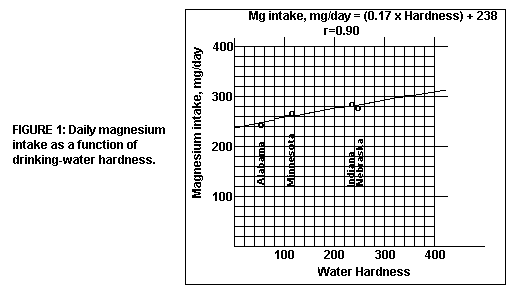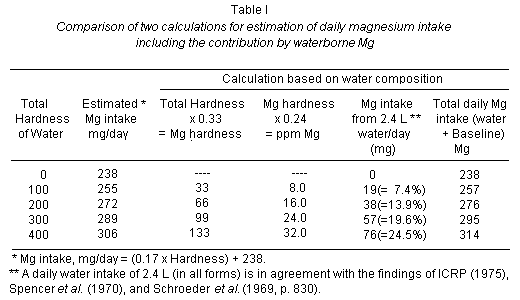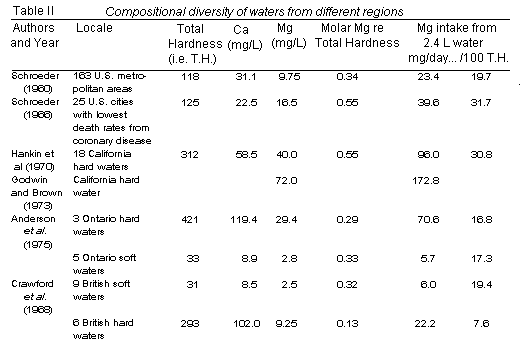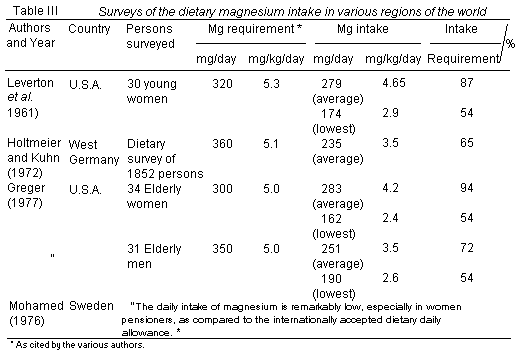In Rev. Can. Biol., vol. 37, n 2, June 1978, p. 115-125
CARDIO-PROTECTIVE CONTRIBUTION OF HARD WATERS TO MAGNESIUM
INTAKE
J. R. Marier
Division of Biological Sciences, National Council of Canada,
Ottawa, Ontario, Canada K1A OR6
The inverse correlation between water hardness and incidence
of cardiac fatalities was first reported in 1957, and has since
been observed in many regions of the world (Masironi, 1972). It
is therefore reasonable to expect that a "common
factor" in drinking-water would largely explain this
global trend, and several researchers have suggested that the
magnesium present in hard waters has a cardioprotective influence
(Parsons et al., 1961; Marier et al., 1963;
Bajusz, 1967; Marier, 1968; Holtmeier, 1969; Anderson, 1972).
Recent Canadian studies have reinforced the hypothesis that
hard-water magnesium may play a crucial role in the prevention of
cardiac ailments. In a nation-wide survey of 15 elements present
in 575 drinking-waters (Neri et al., 1975, 1977) m,
magnesium emerged as the most likely "candidate
element" on the basis of several criteria, i.e., it was
present in more than 10% of the sampled waters; magnesium is a
consistent function of the softness-hardness gradient; magnesium
represents a significantly-high proportion of the daily intake
from other sources; the known metabolic effects of magnesium are
consistent with the hardness-mortality trend. Furthermore,
analysis of 350 tissue samples from 161 autopsy cases (Anderson
et al., 1973, 1975) revealed that myocardial magnesium
was 6% lower in "cardiac death" patients from
soft-water localities, in comparison with hard-water regions;
also, myocardial magnesium in all "cardiac
death" tissues averaged 22 % lower than in the group of
non-cardiac fatalities. A similar 12-to-15% lower heart-muscle
magnesium content in sudden-death cardiac cases has also been
reported in Britain (Chipperfield and Chipperfield, 1973; Behr
and Burton, 1973), as well as a 33% lower magnesium content in
coronary arteries of sudden-death cardiac cases in soft-water
regions (Crawford and Crawford, 1967).
Thus, there is compelling evidence to support the involvement
of waterborne magnesium in a cardio-protective role. The
beneficial effects of magnesium on the heart, along with the
adverse effects of an inadequate magnesium intake, are well
documented (Simon, 1963; Marier, 1968; Holtmeier, 1969; Szelenyi,
1973) and make it a prime candidate to explain the "water
factor" (Seelig and Heggveit, 1974; Marier, 1976;
Chipperfield and Chipperfield, 1977; Anderson, 1977; Burch and
Giles, 1977). Clinically, magnesium has been found to have a
vasodilator effect in hypertensive patients, and also increases
cardiac output in all patients (Mroczek et al., 1977;
Szelenyi, 1973), and is used in the stabilization of cardiac
rhythmicity (Chadda et al., 1972, 1973, 1976, 1977;
Singh et al., 1975, 1976a, 1976b, 1976c; Babaknia and
Niebyl, 1978).
But, in spite of the above-cited documentation, the magnesium
hypothesis has yet to gain widespread acceptance among those
studying the water-hardness interrelations. The objections focus
on two main points:
(i) waterborne magnesium does not make a significant
contribution to daily total magnesium intake;
(ii) the absence of overt signs of magnesium deficiency
among the general population is a contraindication that
waterborne magnesium serves as an important means of
supplementation.
This presentation will attempt to shed further light on the
overall situation.
To assess the impact of any waterborne component, some idea of
its contribution to total daily intake is required. Figure 1
presents the type of data that is very difficult to find in the
scientific literature: it plots daily magnesium intake as a
function of water hardness in various regions. Data for 3 of the
4 regions were obtained from the study by Leverton et
al. (1961), and represent magnesium intake from
self-selected diets in Alabama (6 subjects), Minnesota (7
subjects), and Nebraska (7 subjects); the other value was
obtained from Greger's (1977) survey of (34) subjects in Indiana.
All of the subjects were women, aged 19 to 24 in the study by
Leverton et al., and aged 70 to 81 in the study by
Greger. The water hardness data are taken from Schroeder's (1960)
compilation, and represent State-wide averages; this was the only
data readily available.

Although the day-to-day variability in intake of magnesium
from self-selected diets is large (± 23%), a linear
regression line was drawn through the various points that
represent "average magnesium intake", and this
allows an estimation of the contribution made by waterborne
magnesium (Figure 1). Note that, at "zero" water
hardness, the trend indicates a daily magnesium intake of 238 mg,
but that the intake can be 306 mg/day at a water hardness of 400
(i.e., where hardness is expressed as mg CaCO3/L); on this basis,
a water with a hardness of 400 contributes 68 mg of additional
magnesium per day.

In Table I, calculations obtained from the regression equation
in Figure 1 are intercompared with calculations based on water
composition per se. Note the good agreement between the
values obtained by both methods of calculation. Note also that
each 100 units of hardness contributes 6 to 7% of the estimated
total magnesium intake per day; thus, a water with a total
hardness of 400 contributes 24.5% of the magnesium intake, and
this in fairly good agreement with the 27% contribution that
Hankin et al. (1970) reported for a water hardness of
347. In Table I, the factor of 0.33 (i.e., for the Molar
contribution of magnesium to total hardness) is close to the
average of 0.34 that Schroeder (1960) reported for 163 U.S.
metropolitan areas, and this indicates that the waters of the 4
regions depicted in Figure 1 are of this general compositional
type.

Table II illustrates the diversity that can be encountered in
hard waters from different regions. In particular, note that the
25 U.S. cities with the lowest death-rates from coronary disease
(Schroeder, 1966) are proportionately richer-than average in
their magnesium content, and therefore contribute significantly
more magnesium per unit of water hardness; in fact, these waters
resemble the California hard waters studied by Hankin et
al. (1970). In comparison, the Ontario waters studied by
Anderson et al. (1975) are comparable to the average for
U.S. metropolitan areas (Schroeder, 1960), as are the soft
British waters studied by Crawford et al. (1968).
However, note that Crawford et al.'s hard waters are
relatively poor in magnesium; thus, these very hard British
waters contribute the same low amount of magnesium calculated for
the 163 U.S. metropolitan areas (Schroeder, 1960). This may
explain why the British have been unable to find any significant
correlation with waterborne magnesium in their water-hardness
surveys; however, the lack of information on (non-water) intake
of dietary magnesium in Britain leaves this entire question open.
In summary, the contribution that waterborne magnesium makes to
total magnesium intake is dependent on the characteristics of the
waters in a particular region. Nevertheless, it is obvious that
North American hard waters (i.e., hardness > 100) generally
contribute about 23 mg of dietary magnesium per day, but that
this waterborne contribution can be about 2, 3, or 4 times (or
more) greater, depending on the degree of water hardness and/or
the compositional makeup of waters containing a
higher-than-normal proportion of magnesium (Table II).
In a comprehensive review of human magnesium requirements
Seelig (1964) recommended an intake of 6 mg/kg/day, and this is
equivalent to a daily intake of 360 or 420 mg by persons weighing
60 or 70 kg, respectively. However, Manalo et al. (1967)
have calculated that the daily magnesium requirement for a 70 kg
man ranges from 265 to 350 mg. In short-term balance studies,
Leverton et al.'s (1961) data reveal a daily magnesium
requirement of 320 mg for young women, whereas the data of Jones
et al. (1967) indicate a requirement of 280 mg/day in a
mixed population of adults. Overall, it would seem that a
reasonable estimate of magnesium requirement in adults is about
300 mg/day, or somewhat higher. (Jones et al. (1967) and
Schroeder et al. (1969) have cautioned against the
practice of expressing magnesium requirement on a "per kg body
weight" basis, because the magnesium required by normal and obese
persons is quasi-identical.)
Schroeder et al. (1969) have suggested that a
magnesium intake as low as 200 mg/day might be adequate for
adults; however, in a recent East German review, Fehlinger and
Seidel (1977) conclude that such a low intake should be
considered "minimal", i.e., it probably
represents a mere subsistence level.

In Table III, it can be seen that the magnesium intake
observed in the U.S.A. and Europe falls considerably short of the
daily requirements cited by the various authors. As discussed by
Seelig (1964), Caddell (1972), Marier (1976), and Fehlinger and
Seidel (1977), and as illustrated by Schroeder et al.
(1969), Schroeder (1971), and Hamilton and Minski (1972/3), the
reasons for the widespread dietary magnesium inadequacy are
largely attributable to the loss of magnesium during processing
of food staples, e.g.,
% of magnesium lost
Refining of flour from wheat 80
Polishing of rice 83
Production of starch from corn 97
Extraction of white sugar from molasses 99
Note that, in Table III, magnesium intakes as low as 162
mg/day have been observed, and average intakes range from 235 to
283 mg/day. In Figure 1, the linear regression indicated a
"baseline" magnesium intake (at
"zero" water hardness) of 238 mg/day, and this
is very close to the average intake of 235 mg/day that Holtmeier
and Kuhn (1972) reported in West Germany. In Table II, it has
been shown that hard waters can contribute from 39 to 96 (or
more) mg of magnesium per day, and it can therefore be
appreciated that waterborne magnesium can "make the
difference" between inadequacy and sufficiency.
Three further comments are warranted, concerning waterborne
magnesium, i.e.,
(i) Arnaud's (1977) autoradiographic study of magnesium
uptake from sulfated mineral water has indicated that 40 to 50%
of the waterborne magnesium is absorbed. In comparison, only
33% of the magnesium in a normal diet is absorbed (cf Burch and
Giles, 1977). It is therefore possible that hard-water
magnesium is "more available" than an
equivalent amount of dietary magnesium; if so, this would imply
a greater metabolic significance for the proportion of
magnesium contributed by water.
(ii) Epidemiological studies should include consideration of
the extent to which water-softening devices are used in a given
locality. Failure to allow for this factor may obscure an
otherwise-detectable interrelation.
(iii) A beneficial effect of waterborne magnesium can only
be expected where the magnesium intake from other sources is
inadequate.
The lack of obvious evidence of widespread magnesium
deficiency in human populations has led some authors (Jones
et al. 1967; Schroeder et al., 1969) to
conclude that the dietary magnesium intake is generally adequate,
and they have therefore seen no need for supplementation. These
authors were referring to acute magnesium deficiency
(see Fehlinger and Seidel, 1977); however, it is likely that a
much more subtle form of magnesium insufficiency is prevalent in
the modern-day world.
The current dietary intake of magnesium has been termed
"marginally inadequate" (Anderson, 1977),
whereas the degree of magnesium deficiency has been called
"chronic low-grade" (Burch and Giles, 1977) and
"sub-acute" (Neri et al., (1975). It is
therefore not surprising that there have been no overt signs of
magnesium insufficiency among the general population.
As illustrated by Masironi (1972) and Anderson (1978), today's
world is confronted by an "epidemic" of
sudden-death ischemic heart disease which afflicts people in the
25-to-50 yr. age-group and accounts for approximately one-half of
all deaths in middle-aged men (Anderson, 1977). In 1969, Anderson
et al. proposed that the "water factor"
relates entirely to sudden-death cardiac seizures which occur
because the myocardium itself can become overly vulnerable to
infarction; this proposal elicited favorable comment from
Schroeder (1969), and there is now considerable evidence to
support it, i.e.,
(i) Sudden-death cardiac subjects were found to have lower
magnesium levels in heart muscle, in comparison with those who
had died from other causes (Chipperfield and Chipperfield,
1973; Behr and Burton, 1973);
(ii) Sudden-death cardiac cases in a soft-water locality had
a lower magnesium level in coronary arteries, in comparison
with similar subjects from a hard-water region (Crawford and
Crawford, 1967);
(iii) Myocardial magnesium concentrations were lower in
soft-water areas than in hard-water regions, whether the
cause-of-death was cardiac-related or not (Anderson et
al., 1975);
(iv) Myocardial tissue can become selectively depleted of
magnesium, whereas the magnesium content of skeletal,
diaphragm, and pectoralis muscles remain unchanged (Behr and
Burton, 1973; Seelig and Heggtveit, 1974; Anderson et
al., 1975), and no change may be seen in serum and /or
erythrocyte magnesium concentration (Chaparwal et al.,
1971; Zieve, 1975; Anderson, 1977).
The consequences of magnesium depletion (especially at the
cardiac site) are an increased likelihood of cardiac arrhythmia,
calcification, necrosis, and infarction (Holtmeier, 1969;
Szeleny, 1973; Seelig and Heggtveit, 1974; Marier, 1976; Burch
and Giles, 1977). It is relevant to note that, of the two main
intracellular cations, magnesium--but not potassium--has been
effective in the stabilization of cardiac arrhythmia (Chadda
et al., 1972), in the prevention of adrenalin-induced
cardiopathy (Savoie, 1971), and in maintaining myocardial
integrity during cardiac arrest (Kalmar et al., 1975;
Tyers, 1975). The beneficial role of magnesium has also been
discussed in the enhancement of thiamin utilization (Zieve,
1975), and in the prevention of histamine shock during
"sudden unexpected death" syndrome (Caddell,
1972).
As for an underlying mechanism that might explain the role of
magnesium insufficiency in sudden-death cardiac seizures, it can
be suggested that the earliest site-of-action (and probably the
most critical) is within the heart mitochondria (Heggtveit et
al., 1964; Seelig and Heggtveit, 1974; Jacobus et
al., 1975; Crompton et al., 1975; Ryan and Ryan,
1977). It is possible that the heart mitochondria are the
organelles that respond most readily to an inadequate magnesium
intake, thereby tending to become selectively depleted of
magnesium, with consequent impairment of the heart's ability to
respond to a sudden surge of stimulus (e.g., adrenalin). Future
work may show that dietary magnesium requirements should be based
on the maintenance of mitochondrial integrity. Meanwhile, these
words by Héroux et al. (1977) can be used to
summarize the current situation, i.e.
"There is a level of magnesium deficiency which is
characterized by few overt signs of the deficiency, but
which--over the long term--results in a decline in homeostatic
potential."
ABSTRACT
The reported inverse correlation between water
hardness and incidence of cardiac fatalities has led to tentative
hypotheses concerning the role of magnesium intake in this
phenomenon. The present article reviews the evidence in favor of
the magnesium hypothesis, with emphasis on differentiating
between diet-derived and waterborne magnesium intake, and their
respective cardio-protective potentials.
REFERENCES
ANDERSON, T.W., W.H. LERICHE and J.S. MACKAY (1969); "Sudden
Death and Ischemic Heart Disease--Correlation with Hardness of
Local Water Supply", New Engl. J. Med., 280:
805.
ANDERSON, T.W. (1972): "Can Water Cause Heart Disease?",
in Proc. 6th Internat. Water Qual. Symp., April 18-19,
Washington, D.C., p. 28-31.
ANDERSON, T.W., D. HEWITT, L.C. NERI, G. SCHREIBER and F.
TALBOT (1973): "Water hardness and Magnesium in Heart Muscle",
Lancet, Dec. 15/73, p. 1390.
ANDERSON, T.W., L.C. NERI, G. SCHREIBER, F.D.F. TALBOT and A.
ZDREJEWSKI (1975): "Ischemic Heart Disease, Water Hardness, and
Myocardial Magnesium", Canad. Med. Assoc. J.,
113: 199.
ANDERSON, T.W. (1977): "Water Hardness, Magnesium, and
Ischemic Heart Disease", Nova Scotia Med. Bull., April,
p. 58.
ANDERSON, T.W. (1978): "A New View of Heart Disease", New
Scientist, February 9, p. 374.
ARNAUD, M.J. (1977): "Autoradiographic Study in the Rat of the
Transit of Magnesium from Mineral Water", Acta Pharmacol.
Toxicol., 41: 154.
BABAKNIA, A. and J.R. NIEBYL (1978): "The Effect of Magnesium
Sulfate on Fetal Heart-rate Baseline Variability", Obstetrics
and Gynecol., 51: 2-s.
BAJUSZ, E. (1967): "Heart Disease and Soft and Hard Water",
Lancet, April 1, p. 726.
BEHR, G. and P. BURTON (1973): "Heart-muscle Magnesium",
Lancet, August 25, p. 450.
BURCH, G.E. and T.D. GILES (1977): "The Importance of
Magnesium Deficiency in Cardiovascular Disease", Amer. Heart
J., 94: 649.
CADDELL, J.L. (1972): "Magnesium Deprivation in Sudden
Unexpected Infant Death", Lancet, August 5, p. 258.
CHADDA, K.D., P.K. GUPTA and E. LICHSTEIN (1972): "Magnesium
in Cardiac Arrhythmia", New Engl. J. Med.,
287: 1102.
CHADDA, K.D., E. LICHSTEIN and P. GUPTA (1973):
"Hypomagnesemia and Refractory Cardiac Arrhythmia in a
Non-digitalized Patient", Amer. J. cardiol.,
31: 98.
CHADDA, K.D., T. REILLY, E. LICHSTEIN and P.K. GUPTA (1976):
"Alteration of serum magnesium in acute myocardial infarction",
Clin. Res., 24: 611-A.
CHADDA, K.D., E. LICHSTEIN, P.K. GUPTA and P. COKALINGAM
(1977): "Hypomagnesemia and Cardiac Arrhythmia", Clin.
bRes., 25: 544-A.
CHAPARWAL, B.C., S. MEHTA and S.D. SINGH (1971): "Magnesium
levels in Serum, Erythrocytes, and Urine in Protein-calorie
Malnutrition", Indian J. Pediatr., 38:
162.
CHIPPERFIELD, B. and J.R. CHIPPERFIELD (1973): "Heart-muscle
Magnesium, Potassium, and Zinc Concentrations after Sudden-death
from Heart Disease", Lancet, August 11, p. 293.
CHIPPERFIELD, B. and J.R. CHIPPERFIELD (1977): "Magnesium and
the Heart", Amer. Heart J., 93:
679.
CRAWFORD, T. and M.D. CRAWFORD (1967): "Prevalence of
Pathological Changes of Ischaemic Heart Disease in a Hard-water
and in a Soft-water Area", Lancet, February 4, p.
229.
CRAWFORD, M.D., M.J. GARDNER and J.N. MORRIS (1968):
"Mortality and Hardness of Local Water Supplies",
Lancet, April 20, p. 827.
CROMPTON, M., M. CAPANO and E. CARAFOLI (1976):
"Respiration-dependent Efflux of Magnesium Ions from Heart
Mitochondria", Biochem. J., 154:
735.
FEHLINGER, R. and K. SEIDEL (1977): "Zur human biologischen
bedeutung des magnesiums unter besonderer berucksichtigung der
ernahrung", Deutsche Gesundheitswesen,
32: 28.
GODWIN, J.D. and C. BROWN (1973): "Magnesium and Sudden
Unexpected Infant Death", Lancet, May 26, p. 1176.
GREGER, J.L. (1977): "Dietary Intake and Nutritional Status in
Regard to Zinc of Institutionalized Aged", J. Gerontol.,
32: 549.
HAMILTON, E.I. and M.J. MINSKI (1972/73): "Abundance of the
Chemical Elements in Man's Diet and Possible Relationship with
Environmental Factors", Sci. Tot. Environ.,
1: 375.
HANKIN, J.H., S. MARGEN and N.F. GOLDSMITH (1970):
"Contributions of Hard Water to Calcium and Magnesium Intakes of
Adults", J. Amer. Diet Assoc.,
56:212.
HEGGTVEIT, H.A., L. HERMAN and R.K. MISHRA (1964): "Cardiac
Necrosis and Calcification in Experimental Magnesium Deficiency",
Amer. J. Pathol., 45: 757.
HÉROUX, O., D. PETER and H.A. HEGGTVEIT (1977):
"Long-term Effect of Suboptimal Dietary Magnesium on Magnesium
and Calcium Contents of Organs, on Cold Tolerance, and on
Life-span, and its Pathological Consequences in Rats): ", J.
Nutr., 107: 1640.
HOLTMEIR, H.J (1969): "Magnesiumstoffwechselstorungen und
herzinfarkt", in Symposium "Herzinfarkt und Schock",
Freiburg, November 8-9, 1968, Edit., by L. Heilmeyer and H.J.
Holtmeier, Publ. by Georg Thieme Verlag, Stuttgart.
. HOLTMEIER, H.J. and M. KUHN (1972): "Zinc und magnesium
mangel beim menschen", Therapiewoche,
22 : 4536.
ICRP (1975): "International Commission for Radiation
Protection, Publication 23", report of the Task Group on
Reference Man., Oxford, Publ. by Pergamon Press.
JACOBUS, W.E., R. TIOZZO, G. LUIGLI, A.I. LEHNINGER and E.
CARAFOLI (1975): "Aspects of Energy-linked calcium Accumulation
by Rat-heart Mitochondria", J. Biol. Chem.,
250: 7863.
JONES, J.E., R. MANALO and E.B. FLINK (1967): "Magnesium
Requirements in Adults", Amer J. Clin. Nutr.,
20: 632.
KALMAR, P., N. BLEESE, V. DORING, G.GERCKEN, U. KIRSCH, W.
LIERSE, H. POKAR, M.J. POLONIUS and G. RODEWALD (1975): "Induced
Ischemic Cardiac Arrest", J. Cardiovasc. Surg.,
16: 470.
LEVERTON, R.M., J.M. LEICHSENRING, H. LINKSWILER and F. MEYER
(1961): "Magnesium Requirement of Young Women Receiving
Controlled Intakes", J. Nutr., 74:
33.
MANALO, R., R.E. FLORA and J.E. JONES (1967): "A Simple Method
for Estimating Dietary Magnesium", Amer. J. Clin. Nutr.,
20: 627.
MARIER, J.R., D. ROSE and L.F. BELANGER (1963): "Hard Waters
and Heart Disease", Brit. Med. J., September 14, p.
686.
MARIER, J.R. (1968): "The Importance of Dietary Magnesium,
with Particular Reference to Humans", Z. Vitalstoffe
Zivilisations-Krankheiten, 13: (n 4), p.
144.
MARIER, J.R. (1976): Some Current Thoughts on Magnesium,
with Emphasis on the Water-factor and Cardiac Disorders,
Unpublished typescript, 108 p., available from J.R. Marier, Div.
of Biol. Sciences, National Research Council, Sussex Drive,
Ottawa, Canada.
MASIRONI, R. (1972): "Trace Elements in Relation to
Cardiovascular Diseases--The WHO/IAEA Joint-research Programme",
in Symp. Proc. Bled., Yugoslavia, April 10-14, 1972,
edited by M. Kripfner, Publ. by Internat. Atomic Energy Agency,
Vienna.
MOHAMED, A. (1976): "Dietary Intake of Electrolytes and Trace
Elements in the Elderly", Nutrition and Metabolism,
20: 187.
MROCZEK, W.J., W.R. LEE and M.E. DAVIDOV (1977): "Effect of
Magnesium on Cardiovascular Hemodynamics", Angiology,
28: 720.
NERI, L.C., D. HEWITT, G.B. SCHREIBER, T.W. ANDERSON, J.S.
MANDEL and A. ZDROJEWSKI (1975): "Health Aspects of Hard and Soft
Waters", J. Amer. Water Works Assoc., August, p.
403.
NERI, L.C., H.L. JOHANSEN and F.D.F. TALBOT(1977): "Chemical
Content of Canadian Drinking-water Related to Cardiovascular
Health", Publ. by the University of Ottawa.
PARSONS, R.S., T.C. BUTLER and E.P. SELLARS (1961): "Hardness
of Local Water-supplies and Mortality from Cardio-vascular
Disease", Lancet, July 22, p. 213.
RYAN, M.P. and M.F. RYAN (1977): "Muscle Calcium Accumulation
During Magnesium Deficiency in the Rat", Biochem. Soc.
Trans., 5: 1744.
SAVOIE, L.L. (1971): "Role des anti-diuretiques et des
catecholamines dans la prevention de necroses cardiaques
d'origine metabolique", Pathol. Europ.,
6: 445.
SCHROEDER, H.A (1960): "Relation Between Mortality from
Cardiovascular Disease and Treated Water Supplies", J. Amer.
Med. Assoc, 172: 98/1902.
SCHROEDER, H.A. (1966): "Municipal Drinking-water and
Cardiovascular Death-rates", J. Amer. Med. Assoc.,
195: 81-125.
SCHROEDER, H.A (1969): "The Water Factor", New Engl. J.
Med., 280: 836.
SCHROEDER, H.A., A.P. NASON and I.H. TIPTON (1969): "Essential
Metals in Man--Magnesium", J. Chron. Dis.,
21: 815.
SCHROEDER, H.A (1971): "Losses of Vitamins and Trace Minerals,
resulting from Processing and Preservation of Foods", Amer.
J. Clin. Nutr., 24: 562.
SEELIG, M.S. (1964): "The Requirements of Magnesium by the
Normal Adult", Amer. J. Clin. Nutr.,
14: 342.
SEELIG, M.S. and H.A. HEGGTVEIT (1974): "Magnesium
Inter-relationship in Ischemic Heart Disease", Amer. J. Clin.
Nutr., 27: 59.
SIMON, H.K. (1963): Magnesium--Physiologie, Pharmakologie,
Klinike, Stuttgart, Publ. by Wissenschaftliche
VerlageGesellschaft, MBH.
SINGH, R.B., V.P. SINGH and H.S. BAJPAI (1975): "Refractory
Cardiac Arrhythmia Due to Hypomagnesemia", Acta
Cardiol., 30: 499.
SINGH, R.B., M.D. MANMOHAN, K.P. DUBE and V.P. SINGH (1976a):
"Serum Magnesium Concentrations in Atrial Fibrillation", Acta
Cardiol., 31: 221.
SINGH, R.B., V.P. SINGH, V.K. JHA and B.C. KATIYAR (1976b):
"Magnesium and the Heart", Acta Cardiol.,
31: 401.
SINGH, R.B., K.P. DUBE and P.K. SRIVASTAV (1976c):
"Hypomagnesemia in Relation to Digioxin Intoxication in
Children", Amer. Heart J., 92: 144.
SPENCER, H., I. LEWIN, E. WIATROWSKI and J. SAMACHSON (1970):
"Fluoride Metabolism in Man", Amer. J. Med.,
49: 807.
SZELENYI, I (1973): "Magnesium and its Significance in
Cardio-vascular and Gastrointestinal Disorders", World Rev.
Nutr. Diet., 17: 189.
TYERS, G.F.O. (1975): "Metabolic Arrest of Ischemic Heart",
Annals Thorac. Surg., 20: 91.
ZIEVE, L. (1975): "Role of Co-factors in the Treatment of
Malnutrition as Exemplified by Magnesium", Yale J. Biol.
Med, 48: 229.
This page was first uploaded to The Magnesium Web Site on
November 18, 1995
http://www.mgwater.com/




